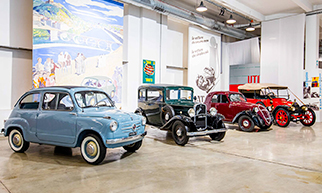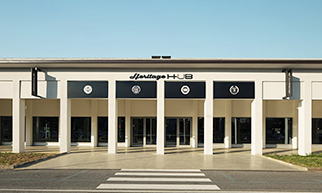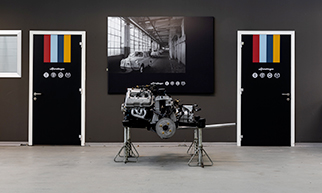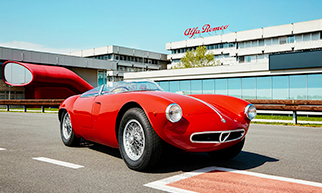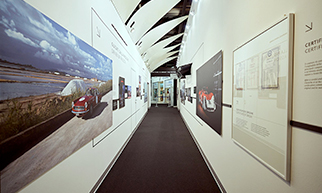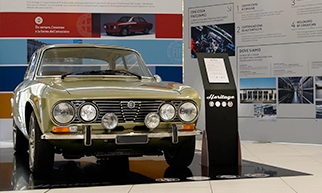On the 120th anniversary of the birth of Dante Giacosa, Stellantis' Heritage Hub is dedicating a celebratory exhibition to the engineer who revolutionized the very concept of mobility.
For over four decades at the helm of FIAT’s engineering and design, Giacosa created some of the most iconic cars of the 20th century, blending technical ingenuity with functional elegance.
Hosted within the evocative spaces of Officina 81 located in Via Plava in Turin, the historic Mirafiori plant in Turin, the temporary exhibition features 10 vehicles displayed at the site’s entrance, along with other masterpieces by Giacosa scattered throughout the Heritage Hub, some of these less well known to visitors as they are located outside the museum’s main thematic areas, such as the Prototipo 100, from which the legendary Fiat 600 was born.
The exhibition will be open to visitors until mid-September 2025 and showcases, in the front row, several of the many models designed by Giacosa: from the Fiat 500 “Topolino” to the versatile 600 Multipla, and the revolutionary Fiat 128. Each car stands as a testament to a vision of mobility that combined technology, accessibility, and forward-thinking, reflecting the extraordinary legacy of Dante Giacosa, the brilliant designer who revoutionized the automotive world and played a key role in motorizing Italy.
Through this initiative, Stellantis Heritage pays tribute not only to the designer, but also to the man who conjugated technical precision with a humanistic spirit—leaving a mark that goes beyond the industrial production.
The exhibition is accessible through the purchase of a standard admission ticket for the Heritage Hub.
The 10 Icons on Display at the Heritage Hub
Proudly and with unmistakable elegance, ten vehicles from the precious Stellantis Heritage collection take to the red carpet, representing the many creations of engineer Dante Giacosa. Each model tells a pivotal chapter in the industrial and social history of Italy, marking significant technical, cultural, and stylistic milestones. The journey begins with the Fiat 500 “Topolino”, the small utility car introduced in 1936, shown here in its 1948 500B version. Esteemed for its performance, it was one of the first Italian cars to combine economy and versatility, low fuel consumption, and great reliability. The nickname “Topolino” (meaning “little mouse”) came from its small size and the shape of the headlights on the fenders, which, when viewed from inside the car, resembled the profile of the famous Disney character. Next comes the Fiat Campagnola, Italy’s first true mass-produced off-roader, launched in 1951, protagonist both in rural areas and military use, and in extreme expeditions like the famous Algiers–Cape Town–Algiers raid. With the Fiat 600 Multipla (1956), Giacosa invented the concept of the minivan: a revolutionary car in terms of space and versatility, capable of carry six people in just over three meters of length. Its layout inspired generations of multi-purpose vehicles and remains a symbol of Italian ingenuity applied to everyday mobility. So we come to 1957, when the legendary Fiat Nuova 500 was unveiled in Turin, symbol of Italy's post-war rebirth and probably the most iconic car ever designed by Dante Giacosa. Compact, simple and ingenious, the 500 was produced until 1975 in over 3.8 million units in different versions. Also displayed at the Heritage Hub its more spacious evolution, the 500 Giardiniera - produced starting from 1960 - Italy’s first true urban station wagon, used by families, merchants, and artisans. In the mid-1960s came the Fiat 124 (1966), which offered a perfect blend of elegance and practicality. It won the prestigious “Car of the Year” title in 1967 thanks to the balance given by its technical innovation, simple construction, and impressive performance. Its robust and simple architecture made it ideal for emerging markets and demanding conditions. The model was also produced under license in several countries, including the Soviet Union, Spain, Turkey, and India. Three years later, 1969 was a key moment, marking the arrival of three key models: the Autobianchi A112, an agile city car created to rival the British Mini and seduce the youth of the time; the Fiat 130, an ambitious luxury flagship designed with great technical and stylistic care to compete with the German brands, and above all the Fiat 128, elected “Car of the Year” in 1970 and considered one of the most revolutionary cars in automotive history: it was the first mass-produced car to feature a transverse front engine with front-wheel drive, an architecture that would become the global standard for compact cars. The exhibition is closed by the Fiat 126 (1972), a modern evolution of the 500, safer, more comfortable, and more accessible. Stylistically derived from the “City Taxi” concept car designed by Pio Manzù in 1968, it was the last Fiat to feature rear-engine, rear-wheel drive, closing the era that began with the Topolino. With over 4.6 million units produced until 2000, the Fiat 126 was also built in Poland, where it became a national icon.
The 70th Anniversary of the Legendary Fiat 600
In addition to celebrating the 120th anniversary of Dante Giacosa’s birth, this year also marks the 70th anniversary of one of his most iconic creations—the Fiat 600, a car that was conceived to help motorize post-war Italy, complementing and eventually surpassing the 500 “Topolino.” This model represented a major technical and economic breakthrough, thanks to its choice of rear-mounted engine and rear-wheel drive. The new Tipo 100 engine, with 633 cc and 21.5 hp, delivers agility, lightness, and cost-effectiveness. The body is load-bearing, the suspension independent: the entire design aims for efficiency in every detail. There is no shortage of original and curious solutions including the headlights, initially on the bonnet, which are moved to the mudguards to simplify production, while the doors, hinged at the rear, have windows in three sections, one of which is made of plexiglass that can be opened with a deflector. Up front, there is a room for the fuel tank, a spare tire, and a small luggage compartment. The cabin, simple yet clever, could be converted by folding down the rear bench into a larger cargo area. Unveiled at the 1955 Geneva Motor Show, it immediately won over the public with its modern lines, four seats, 95 km/h top speed, and affordable price. The model continues to evolve both technically and stylistically, including the iconic 1956 600 Multipla, considered a forerunner of modern multi-purpose vehicles. With the 600D of 1960, engine displacement increases to 767 cc and top speed to 110 km/h. Production continues even after the arrival of the Fiat 850 in 1964, with the two sharing several components. In total, over 4.9 million units are produced in Italy and abroad. It is worth highlighting that the quality of the “Tipo 100” project allows the 600's engine to keep evolving over the years, growing in power and powering many other Fiat models: from the 850 to the 127, from the first Autobianchi A112 Abarth 58 HP to the Panda 45 and even the Fiat Uno 45, passing the baton to FIRE engines which take over in the mid-1980s, though remaining in use until the 2000s. Not only the engine: also the suspension and chassis of the 600 will prove their worth in the legendary racing variants created by Abarth, the 850 and 1000 TC, which will made motorsport history for the Scorpion brand on racetracks around the world. Returning to the Fiat 600, it's worth noting that a charming light blue first-series 1955 model, usually housed at the Centro Storico Fiat in Turin, took part in the 2025 Mille Miglia, driven by an all-female team composed of Laura Confalonieri, deputy editor of Ruoteclassiche, and Valentina Menassi, journalist and contributor to Il Giornale. The historic car completed the demanding route with resilience and reliability, once again embodying the simple yet indomitable spirit of the quintessential Italian city car. It evokes memories of the many privately owned Fiat 600s that, with enthusiasm and limited means, competed in the so-called “minor classes” of the race, reminding us that the Mille Miglia has never been just a race for the elite, but a popular celebration of automotive passion. Lastly, it is also noteworthy to remember that the Abarth 600e and the Fiat 600 Hybrid participated in the 2025 edition of the 1000 Miglia, as Support Cars: the former is the most powerful Abarth ever, with 280 hp and 0–100 km/h acceleration in just 5.85 seconds, while the latter is FIAT’s new “family mover”, equipped with next-gen hybrid technology, offering an extremely smooth driving experience, excellent onboard comfort and low fuel consumption. In this way, a symbolic baton was passed between the historic 600s that raced in the 1960s and their present-day descendants, looking to the future with renewed enthusiasm and bold determination.
Dante Giacosa: Between Technical Rigor and Humanistic Culture
Dante Giacosa born in Rome in 1905 to a family originally from Piedmont, specifically from Neive in the Cuneo area. After completing classical studies, which give him a lifelong sense of balance and proportion, he graduates in Mechanical Engineering from the Polytechnic University of Turin in 1927. He joins Fiat the following year as a design draftsman, beginning one of the most remarkable careers in the history of the Italian automobile industry. After a long period of internal growth, in 1946 he is appointed director of the automotive technical offices, a role in which he will lead the development of all major post-war Fiat models. His first major success is the 500 “Topolino” (1936), followed after WWII by the 1400, 1900, and the Campagnola. With the 600 in 1955, he introduces the rear-engine layout, and with the Multipla, he paves the way for compact, versatile vehicles. 1957 is the consecration year with the Nuova 500, a masterpiece of ingenuity and functionality, symbol of mass motorization in Italy, and winner of the prestigious Compasso d’Oro in 1959. In the following years, he designs iconic models such as the 1800, 1300-1500, the 124 (Car of the Year 1967), the 128 (Car of the Year 1970, Fiat’s first front-wheel-drive model), and the 127 (Car of the Year 1972). He collaborates with Autobianchi on the revolutionary Primula, the first Italian car with front-wheel drive and a transverse engine. Alongside his work at Fiat, he teaches for nearly twenty years at the Polytechnic of Turin, publishes foundational texts such as “Motori Endotermici”, registers 62 patents and holds prominent positions in prestigious international engineering associations. His figure combines engineering vision, aesthetic sense and humanistic culture. In 1970, he leaves Fiat, shortly after being appointed consultant to the Presidency, and devotes himself to memoir activity, recounting the method and passion that guided his entire professional life in the book “I miei 40 anni di progettazione alla Fiat”. He dies in Turin in 1996 at the age of 91. His teachings, still highly relevant today, is grounded in the balance between intuition, simplicity and design rigour. “Designing” - he once wrote - also means evaluating difficulties, identifying essential problems and solving them in the simplest and most complete way”. A legacy that continues to inspire generations of engineers, designers and innovators.
More info on
stellantisheritage.com